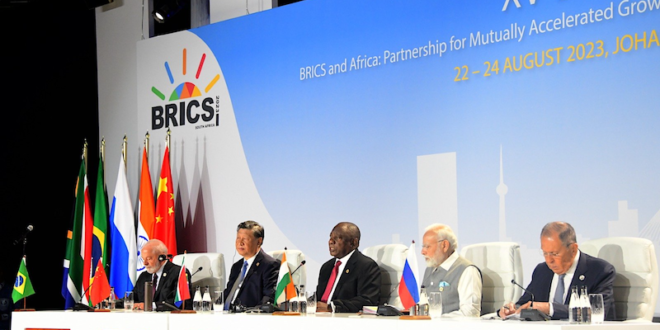After the landmark 15th BRICS Summit in August 2023, foreign policy analysts raised concerns that BRICS — a grouping of Brazil, Russia, India, China, and South Africa at the time — may be seeking to construct an alternate world order and upend Western-led global governance.
Before the 2023 BRICS Summit, 40 countries expressed interest in joining the group and 23 formally applied. In 2024, the group welcomed five new members — Egypt, Ethiopia, Iran, Saudi Arabia and the United Arab Emirates.
The expansion of BRICS prompts speculation about the direction of the group’s mobilisation and possible alternatives to the current global system. If the group manages to reach a consensus on key policy issues, it might exert significant pressure to change the system from within, but it could also use its political and economic power to create a new, potentially parallel system of governance.
Sustaining and expanding a large coalition to challenge the status quo is strenuous work. Yet the BRICS group has evolved into a strategic entity dedicated to system-wide reforms. Waning enthusiasm for US leadership following the global war on terrorism and weakened trust in the Western-led financial system after the global financial crisis created fertile grounds for BRICS countries to cooperate on common goals. The group’s resource investment, multi-level engagement and robust internal processes have deepened policy coordination.
The BRICS group has consistently argued for a more multipolar and democratic order, emphasising the imperative for diversified global leadership and a greater plurality of ideas. This pursuit will likely result in the reduced representation of Western ideas and leaders in global decision-making.
Yet the notion of a parallel order gained prominence as BRICS started institutionalising cooperation. The New Development Bank (NDB) and the Contingent Reserve Arrangement, established by the group with significant investments, have frequently been discussed as alternatives to Western-dominated institutions such as the World Bank and the International Monetary Fund. The track record of the Asian Infrastructure Investment Bank, a China-led multilateral development bank whose membership has nearly doubled since its founding in 2016 to over 100 countries, lends credence to such notions.
In their summit declarations and diplomatic practice, the BRICS members have consistently demonstrated an eagerness to reform the Bretton Woods system and remain in the fold. The formal criteria for becoming a new BRICS member explicitly require the candidate country to support multilateralism and comprehensive UN reform.
There is also significant convergence among major powers. The Rising Power Alliancesproject examined BRICS cooperation between 2009 and 2021 and how it relates to US policy priorities. While the project found deepening convergence among BRICS members overall and in a few areas strategically relevant for the United States, the findings demonstrated limited divergence between the joint policies of BRICS and those of the United States on a wide range of issues.
One area where discourses about alternatives to the current system are most pronounced is these countries’ efforts to move away from the US dollar. Since the group’s establishment, transitioning to local currencies and de-dollarisation initiatives have been important issues on the BRICS agenda. This is gaining momentum. BRICS leaders used the 2023 summit declaration to set a one-year deadline for reporting on the progress of using local currencies, payment instruments and platforms.
As intra-BRICS trade and commodity exports from and imports to member countries are often priced in US dollars, altering these patterns can adversely impact the dollar’s dominance. This is particularly the case in energy trade given that BRICS now accounts for over a third of global production and consumption of oil. The de-dollarisation of these flows can have a significant impact. New efforts to set up an inter-BRICS grain exchange also merit a close watch given these countries’ market share.
The US dollar has already faced a backlash in the oil market, with the BRICS countries increasing non-dollar bilateral trade among them. US officials anticipate a gradual decline in the dollar’s share of global reserves, but the use of alternative currencies for now remains limited. Since most of the BRICS economies and the NDB remain dependent on the dollar, there is little risk to its near- to medium-term dominance.
BRICS members exist in a symbiotic relationship with the Western-led global governance system — their development is contingent upon it, and they seem committed to operating within its framework. This is partially a result of path dependence and, more importantly, an indicator of their benefit from the system.
Yet, as BRICS straddles old institutions and its new ambitions, its institutional trajectory is likely to evolve, particularly in connection with its original aspiration to be the voice of the Global South. With great power comes great responsibility and it remains to be seen whether BRICS can deliver the greatest good for less developed countries, whose wellbeing it seeks to advance.
The real appeal of BRICS in the Global South lies less in the group’s top-down rhetoric and more in the new ideas to advance wellbeing and inclusive economic prosperity from the bottom up and the middle out. With ‘the achievement of the UN Sustainable Development Goals (SDGs) in peril’ — barely 15 percent of the targets on track and the World Bank undergoing major reforms, BRICS has an opportunity to step up with development funding and new initiatives.
For example, the current BRICS members are laboratories for digital and financial inclusion and innovation with rapidly evolving digital economies, as evidenced by our Digital Intelligence Index. Such innovations are extremely relevant in the Global South, where many of the world’s 1.5 billion people are excluded from the formal financial system, and many of the billion people living in internet poverty reside. The group’s efforts have not been proportionate with their shared intent to be perceived as a champion of the Global South. BRICS has yet to effectively leverage the digital development expertise of its member states.
It remains to be seen whether the bloc can design, share and scale concrete policy solutions as the 2024 BRICS presidency implements the Strategy for BRICS Economic Partnership 2025, with the digital economy at the forefront of its agenda.
BRICS member states would do well to harness best practices from within the bloc and corral their digital innovators in the public and private sectors to advance inclusion among the 40 countries seeking inspiration and new development opportunities from BRICS and NDB. Aligning the digital development activities of the NDB more closely with the World Bank’s acceleration efforts would support the bloc’s relationship with Bretton Woods institutions and greatly assist the Global South in reaching the SDGs. Top of Form
The expanded BRICS is poised to persist in both aligning with the existing system where desirable and advocating for specific changes when necessary. It will need to reach a consensus on its priorities and where to deploy its bargaining power. To provide a compelling alternative to the status quo, it must demonstrate a distinctive vision for the Global South and expedite development progress. Otherwise, it risks either becoming the new G77 — an unwieldy political coalition in a deadlocked multilateral system — or the new anti-globalisation movement, a shrill critic of globalisation incapable of designing and scaling alternative and transformational ideas.
 Eurasia Press & News
Eurasia Press & News




